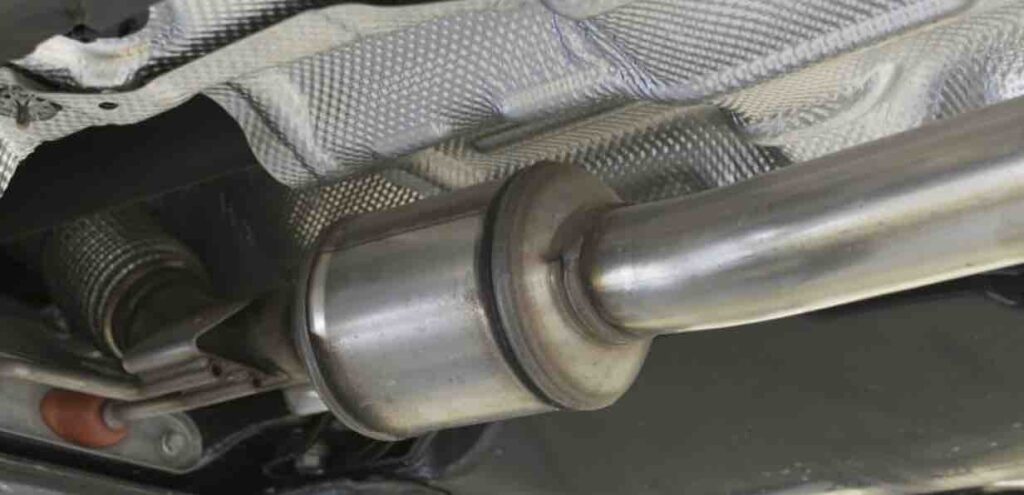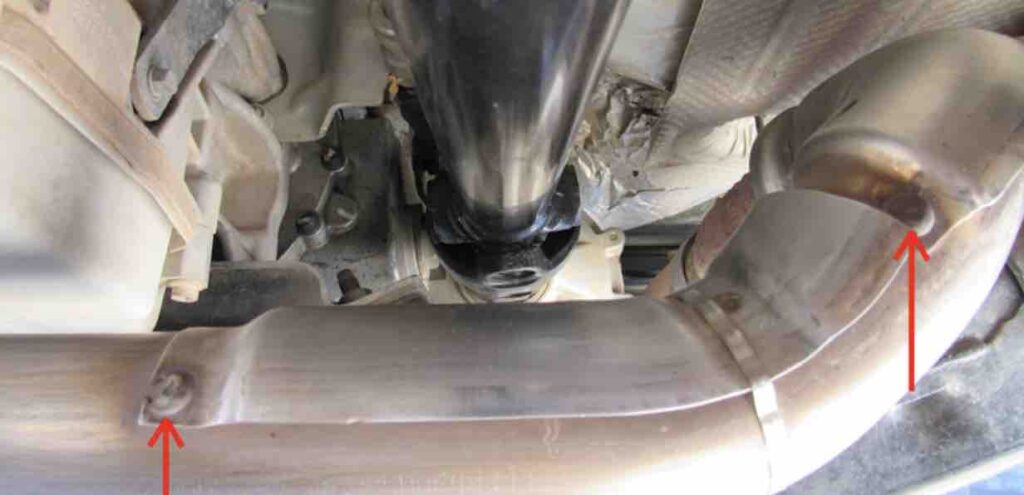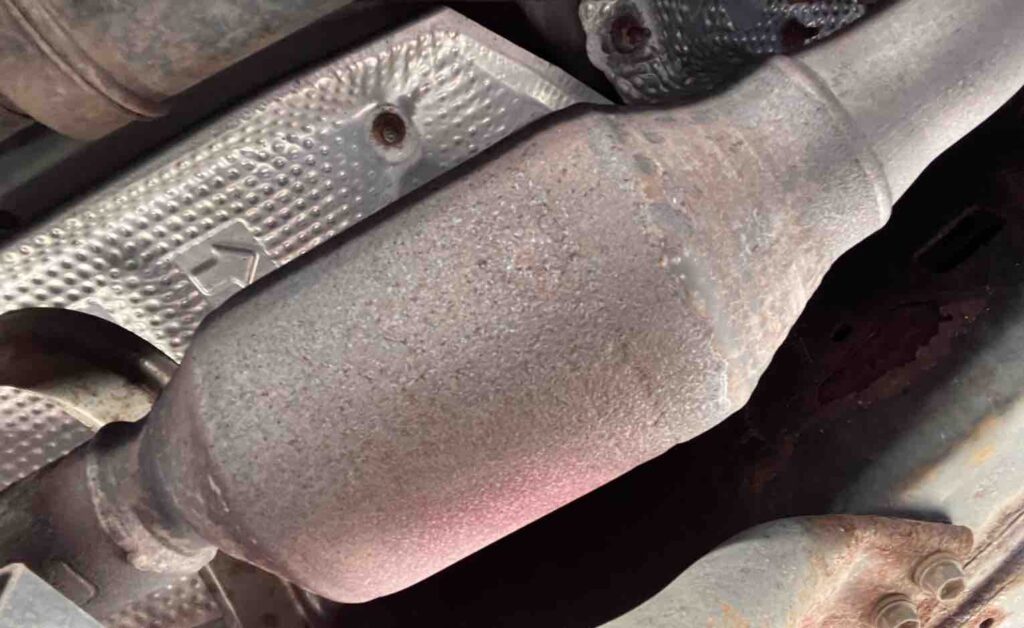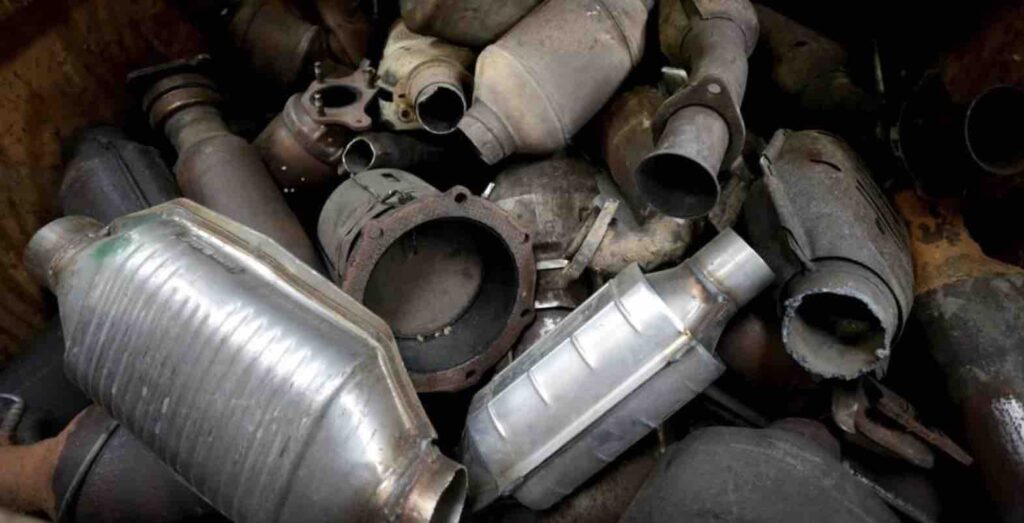Last updated on March 24th, 2023 at 10:06 am
If you are having a Catalytic converter heat shield rattle problem, then this is the post for you to take through the catalytic converter heat shield rattle issue, sound, and how to fix a heat shield rattle solution.
When driving your vehicle, a rattling sound typically indicates that something is wrong. If there is a compromise to your vehicle, this also puts a damp rag on your safety. A rattling heat shield may be an annoyance for some, but it may be embarrassing for others. In some instances, a sagging heat shield can be a significant issue.

The catalytic converter is a necessary element of any car’s exhaust system, which converts harmful engine gases into cleaner exhaust fumes. Unfortunately, this component may produce an audible hissing noise that could distract drivers.
This article will examine the role of catalytic converters, their causes, and five solutions to this issue. And we are going to also consider the following questions
How does a heat shield rattle sound? Catalytic converter heat shield rattle: how to fix a heat shield rattle, How much to fix heat shield rattle Do I need a heat shield on my catalytic converter, how to fix exhaust heat shield rattle, and Cat converter heat shield rattle how to fix it.
How does a heat shield rattle sound
If the heat shield on your catalytic converter is damaged, loose, or clogged, you may hear a rattling noise. Clean out any residue from the inside, and this should solve the issue quickly. Additionally, tightening your heat shield or switching to high-octane gasoline may reduce noise levels.
The basics of How a catalytic converter functions?
Catalytic converters are essential in the conversion of harmful compounds generated during car combustion into safer gases that can be expelled through the exhaust pipe.
The catalytic convert is located beneath a car’s exhaust system, usually between the engine and muffler. To transform engine emissions into safer gases, this device utilizes an internal catalyst.
Cat housings are composed of ceramic honeycomb, which is lined with metal parts such as:
- Platinum
- Palladium
- Rhodium
These metal catalysts plays an essential role in helping catalytic converters perform their function in reducing gases and oxidations.
So reduction catalysts help reduce harmful Nitrogen oxides into harmless Nitrogen and Oxygen, while oxidation catalysts add oxygen and carbon monoxide in order to transform them into CO2 or carbon dioxide.
The catalytic converter is a large metal box located beneath the car with an input pipe at one end. This pipe connects it to the engine to filter out harmful fumes into the catalyst for cleaning purposes.
Once the gases have been converted to safer fumes or steam, they exit through an output pipe connected to the tailpipe. Additionally, an oxygen sensor plays a vital role in this step-by-step catalytic converter process.
The O2 sensor transmits data to the ECU regarding the Oxygen content of exhaust gases. This ensures that the correct amount of oxygen is supplied to the catalytic converter by the engine.
Modern exhaust systems use catalytic converters, which have been around since the 1990s. Their purpose is to reduce pollution and make the air cleaner and safer for everyone.
Why does my catalytic converter make noise?
As with any car component, there can be issues with the catalytic converter. It may become damaged or worn out over time due to normal wear and tear.
If your catalytic converter is making unusual noises, it could be an indication of failure. Common signs that your converter may be malfunctioning include:
- Ticking
- Knocking
- Rattling
- Popping/pinging
A rattling catalytic convert will sound worse in cold weather, though it’s present regardless. You’ll hear both the rattling sound and a knocking or ticking noise when you press the accelerator pedal.
Common causes of rattling from the catalytic convert include:
- Breakage of the ceramic honeycomb structure.
- A heat shield that is loose.
- Dirt and buildup of Oil.
- Maybe, it is just time to replace your catalytic converter.
1. Broken Ceramic Honeycomb Structure
Drivers may hear a rattling sound coming from the catalytic convert during acceleration. This could be an indication that its ceramic honeycomb structure has been damaged.
The ceramic honeycomb structure may experience normal wear and tear over time, which may cause the rattling sound. Furthermore, a direct impact on the catalytic converter can damage the cat structure.
2. A heat shield that is loose.
A catalytic converter may rattle if its heat shield is loose. Without proper tightening, this shield may become loose or corroded.
Although it may appear to be a minor issue, loose or corroded bolts can cause considerable noise. Furthermore, the catalytic converter produces considerable heat, so the heat shield protects other components of your car.
Losing a heat shield not only causes inconvenience but it’s also dangerous and should be addressed right away.
3. Dirt and buildup of Oil.
Over time, the catalytic converter can become clogged. This may result in noises such as rattling or clicking when it isn’t functioning correctly. Dirt and residue accumulation inside of it could block its ability to convert gases effectively.
4. Maybe, it is just time to replace your catalytic converter.
Catalytic converters are typically built to last between 70,000 and 100,000 miles. Some cat converters may last a little more miles, depending on your usage and maintenance of the vehicle over the years. So if you’ve been driving your car for some years and the miles have increased significantly, it may be time for a replacement.
You may hear a rattling sound and other indications that your catalytic converter is failing (these will be discussed later).
How to Fix a Noisy Catalytic Converter – Five Common Fixes
There are several methods to fix a rattling catalytic converter in an exhaust system. If you hear rattling noises from your converter, here are Ways To Reduce Catalytic Converter Rattle Noise you can try:
1. Clean and unclog the cat
The catalytic converter may become clogged with oil and another residue, resulting in noise and possibly stopping its proper working function. To resolve the issue, keep your exhaust system clean at all times.
Cleaning a catalytic convertor with sodium hydroxide-based products is possible, though it’s best to remove the exhaust system first. After doing so, you will have an efficient and safe clean!
Apply sodium hydroxide to the catalytic converter and allow to sit for approximately 20 minutes.
Once you have thoroughly soaked the part, rinse it thoroughly and then air-dry it.
2. Clean Away Any Residue
You don’t have to remove the catalytic converter; rather, use lacquer thinner to clean it.
- Start by adding one gallon of lacquer thinner per gallon of fuel in order to do this.
- Lacquer thinner can be an effective way to break down carbon deposits on the catalytic converter. Before adding it to the gas tank, ensure that you have 10 gallons of fuel available for use.
- The next step is to drive your car. This will enable you to thin the lacquer in the exhaust system and clean the catalytic converter.
- Make this method as efficient as possible: drive for approximately 150 miles at 2500 RPMs for 30 minutes.
Once the system has been thoroughly cleaned and dry, any rattle or buzzing sound should diminish and disappear.
3. Tighten the Heat Shield until you hear no more noise.
Catalytic converters can rattle if there is a loose heat shield present. This is the most common cause of rattle, but it’s easily fixable.
If the heat shield on your car doesn’t function correctly, temperatures inside can rise up to 2000F and cause extensive damage to its floor.
To fix a rattled shield, all you have to do is apply some penetrating oils and take out all bolts. After they are gone, take off the heat shield and rinse it with warm soapy water for optimal cleanliness.
After cleaning, you can reattach your heat shield. You have two options: use anti-seize on existing bolts or install new ones with the proper torque. Make sure all bolts are tightened securely before proceeding with the installation.
4. Change Fuel
It may seem counterintuitive, but using a better quality fuel or additive could help fix a rattling converter. High-octane gasoline may improve airflow through your exhaust system and reduce noises associated with rattling noises.
If you are currently using low-octane gasoline, switching to higher-octane fuel may solve your rattling issue.
You can also add fuel additives to your regular gas to help clean the catalytic converter.
5. Replace it
If none of these methods work for you, then it may be time to replace your catalytic converter.
- Catalytic converters, like most car parts, are designed to last the lifetime of the vehicle; however, they start failing around 70,000-100,000.
- When purchasing a replacement catalytic converter for larger engines, there are various factors that can influence the price. A new catalytic converter may be more costly for larger engines due to additional factors.
- Replacement catalytic converters can range in cost from $800 to over $2200, but you can reduce this expense if you can fit it yourself.
- Installing a catalytic converter at home doesn’t need to be left up to an expert mechanic. This video will walk you through the steps necessary to install your new converter properly.

How to Repair a Catalytic Converter Heat Shield Rattle
About an hour before you start working on the converter, spray the heat shield bolts with penetrating oil. The heat shield bolts must be removed first, followed by the heat shield itself. Using header wrap, cut out a few two-inch-long sections. Place a half-dozen washers on the header wrap that are the same size as your heat shield bolts.
Here are the breakdown of the steps:
- Gather all of the tools and materials necessary for this task. You will require penetrating oil, a socket wrench, a hammer, pair of pliers, as well as new bolts and nuts.
- Locate the Heat Shield. Generally, this shield can be found underneath your car near the catalytic converter. Consult your car manual or search online tutorials for assistance locating this component.
- Examine the heat shield for any signs of damage. Look for cracks, rust, or corrosion, which could have caused it to become loose and rattle. If there is damage present, replace the heat shield with a new one.
- Spray penetrating oil on the bolts that hold the heat shield in place and let them sit for a few minutes to loosen them.
- Use a socket wrench to loosen the bolts and nuts that hold your heat shield in place. You may need to use pliers to hold the nuts while you loosen the bolts.
- Remove the heat shield and clean it using warm, soapy water. Be sure to eliminate any dirt or debris that has built up on the shield.
- Apply anti-seize to existing bolts or use a new set of bolts and nuts to reinstall the heat shield. When using new bolts, ensure they have the appropriate torque and are tightened securely.
- Start the car and listen for any rattling sounds. If the sound persists, repeat this process to check for signs of damage or lose bolts.
Repairing a catalytic converter heat shield rattle is an easy and cost-effective way to eliminate annoying noise and enhance your driving experience. If you feel uncertain about making this repair yourself, consult a professional mechanic for assistance.
You may also watch this video
Related article: Free Catalytic Converter Price Guide(Scrap Worth/ Price List)
How does a heat shield rattle sound?
You’ll hear a loud rattle when you go through lower RPMs on a cold start. It will sound as if it is coming from beneath the driver’s seat.
This same sound will be louder at lower engine speeds and change pitch and tone as your speed increases. You’ll need to hire a professional to determine whether your heat shield is broken or simply loose. The heat shield will vibrate and start producing a rattling sound if it becomes loose due to poor hardware or rust damage. You may need to watch this video to hear what does a heat shield rattle sound like.
Catalytic converter heat shield rattle: how to fix a heat shield rattle
A rattling noise can be heard when the headshield loosens and separates.
The heat shield does not have to be removed for this simple method. However, when the heat shield is removed, it can cause problems with nearby wiring, sensors, and rubber components.
Follow these steps to fix a Heat Shield Rattle:
- You might be able to track the heat shield to the exhaust with a welder if you have one. Take care not to burn through the thin metal heat shield or the exhaust pipe.
- You might be able to reattach a bolt-on heat shield by installing new nuts and bolts. Fender washers can fill in the gaps if the holes are too big.
- In some cases, such as when a heat shield has been welded or clamped to an exhaust pipe, stainless steel screw clamps can be used.
- A stainless steel tie, which won’t rust after installation, is another way to repair a loose heat shield. For more significant components like muffler heat shields, connect several.
How much to fix heat shield rattle?
Generally, heat shield rattle repair costs are determined by the extent of the damage. However, To repair and replace, you’ll need to purchase new heat shields, which can cost up to $40 per sheet, and be prepared to remove the old parts and replace them with new ones.
It’s only a few bolts as well as some sheet metal, although it can be a pain. Unless you drive your car to a mechanic, the components will cost around $150, and the labor will take about an hour. So the total bill is expected to be around $300.
Summary on heat shield rattle repair cost:
The parts, consisting of only sheet metal and a few bolts, should cost around $150 at a Honda parts store. And it takes about an hour to complete the task. That means you should budget between $250 and $300 for this service. Read this, too, on this topic
Do I need a heat shield on my catalytic converter?
Yes, in a nutshell. New cars come with a thin sheet of metal below the exhaust system and another on top for the heat inside your vehicle and to protect components that extreme temperatures could damage.
When you park near a source of heat, a heat shield for a car on the underside prevents your engine from setting a fire. In addition, the top-side guard prevents your shoes from melting and fusing with the floor pan.
Even though you can drive without a heat shield, it is an important safety feature that has been installed on your vehicle for a reason. They also preserve tall grass or other flammable items from coming into contact with the vehicle’s underside.
Heat shields protect the underside of your vehicle from incendiary temperatures by preventing the exhaust system from heating the floorboards and other nearby car parts.
How to fix an exhaust heat shield rattle or how to fix a heat shield rattle
Rust and corrosion wreak havoc on the exhaust system, causing rattles. In this case, the muffler or tailpipe will almost certainly need to be replaced. Also, a loose exhaust system clamp can cause a rattle.
All you have to do if the heat shield is loose is tighten it up.
- Start by getting underneath the raised car with the engine off and tighten all of the bolts holding the heat shield in place.
- It’s also possible that something in the road bent the heat shield. Pull the guard away from any places where it might be touching the exhaust pipe with pliers or a screwdriver.
- Ensure the car is in the park, the emergency brake is activated, and the wheels are securely chocked.
- Be careful not to damage the oxygen sensor while you’re hammering and trying to push components around.
Cat converter heat shield rattle
This is one of the most prominent signs of a bad or failing catalytic converter is rattling noises.
The catalyst-coated honeycomb meshes inside a catalytic converter and can collapse or break apart if it becomes old or damaged internally due to unfavorable fuel mixtures, causing a rattle. The rattle may be more noticeable when the vehicle is first started.
A rattling noise coming from under your car is likely coming from your catalytic converter. It could even sound like the engine is making noise. When the catalytic converter is cold, you’re more likely to hear a rattling noise. It’s possible that you won’t hear the cat once it’s warmed up.
How do I stop my catalytic converter from rattling?
In this section, I’ll show you how to stop catalytic converter rattling noise using various methods. All of these strategies can be done at home. Without any further delay, use the methods listed below to stop your catalytic converter from rattling.
- Use Sea FoamCleaner
- The Catalytic Converter Should Be Cleaned
- Sodium Hydroxide is a chemical compound that can be used to make a variety
- Fuel additives and high-octane fuel
- Catalytic Converters must be replaced.
Your catalytic converter will function properly if you follow the steps above. There are several ways to fix the rattle, whether caused by a loose heat shield, buildup in the ceramic honeycomb, or fracturing. Here are seven possible ways to quiet a rattling catalytic converter if you’re looking to address the noise or be proactive and address the possibility before it occurs.
What to read next:
- Effects of Driving with a Bad Catalytic Converter
- The Cheapest Way to Fix Catalytic Converter, Cost & How to Fix

Hi dear, I am Dennis Gift, an autobody repair technician with over 4 years of experience; and I love everything about fitness and cars and researching and sharing my experience. And this is where I get to do that freely without reservations. So come along with me.


